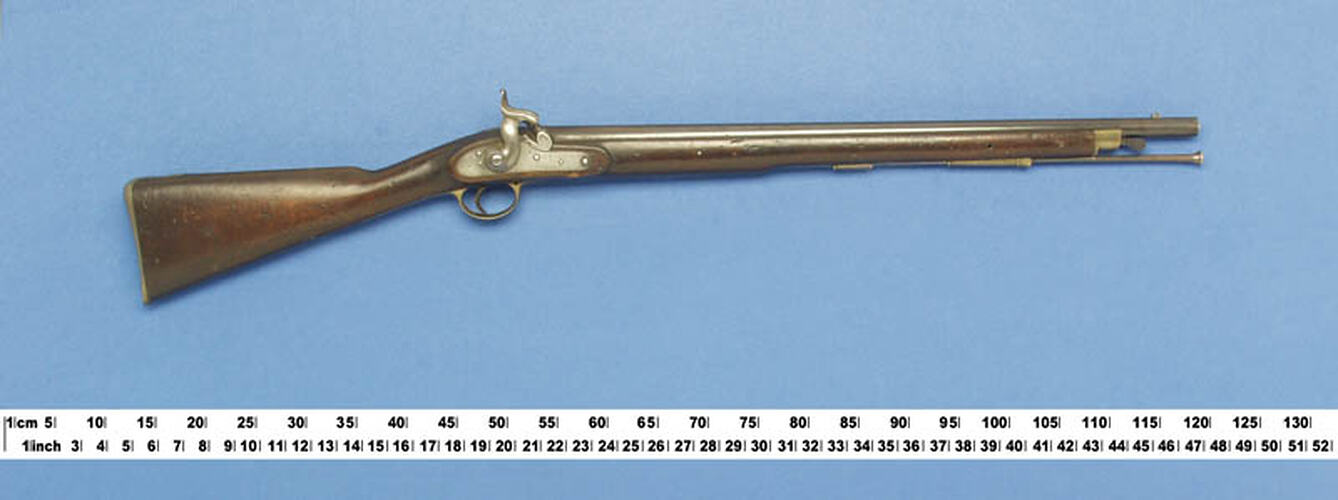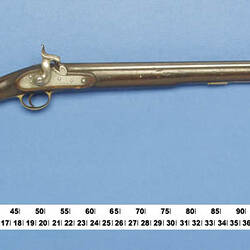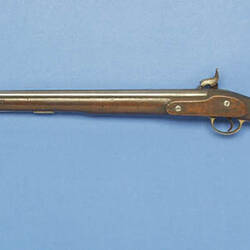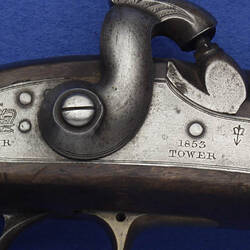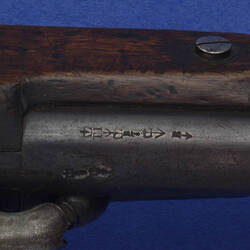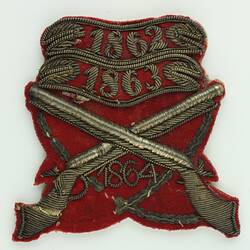Summary
British Service percussion carbine, Pattern 1840 Carbine (Constabulary Carbine), 1853. Cal. .653 in., steel smoothbore round barrel, 676 mm long, with Lovell's bayonet catch on R.H.side.
One of 26 guns donated in 1871 by the Victorian Ordnance Department from its Melbourne Armoury, for the newly created Industrial and Technological Museum. The display was intended to show mechanics and gunsmiths the principles of gun construction and recent technical developments in weapons.
Physical Description
Steel side lock and hammer on R.H. side, brass oval triggerguard with small front spur and longer rear extension, two brass 'Lovell's sidenail cups' for lockplate screws on L.H.side, brass foreend and butt plate, both sling swivels missing. Block foresight used to secure the bayonet, no rear sight, barrel fastened to stock via two barrel pins, steel ramrod, 67.80cm long, and two brass ramrod tubes, the front one being trumpet shaped.
Significance
Dervived from the Pattern 1839 Musket, and similar to the Pattern 1842 Sea Service Muskets and Rifles, the Pattern 1840 Constabulary Carbine is shorter again that the latter, with a 26" barrel. Noticible also is the placement of the rear sling swivel in the stock underside, rather than the triggerguard (missing in this example). Many of those found in Australia used the Pattern 1842 lock hence the alternate name of Pattern 1842 Constabulary Carbine. It was issued across NSW, Victoria, Tasmania, and Western Australia: Victoria models often being of a later variant that used the Pattern 1853 lockplate. This model carries a Pattern 1842 lockplate, but it appears to have the steeper sided hammer of the early 1853 locks.
More Information
-
Collecting Areas
-
Acquisition Information
Donation from Melbourne Armoury, 24 Oct 1871
-
User
Victoria: Ordnance Branch, Melbourne, Greater Melbourne, Victoria, Australia, 1850s-1860s
-
Inscriptions
Stamped on lockplate: crown/ VR, 1853/ TOWER, crown with extending broad arrow Stamped on stock R.H.side: broad arrow over 'BO' (Board of Ordnance) Stamped on stock L.H. side: B.HARPER Stamped on stock behind tang: 53 Stamped on stock behind buttplate tang: 18 Stamped on buttplate tang: 18 Stamped on barrel with Birmingham government proofmarks
-
Model Name or Number
-
Brand Names
-
Classification
-
Category
-
Discipline
-
Type of item
-
Overall Dimensions
107.7 cm (Length), 6 cm (Width), 20.7 cm (Height)
Barrel length: 67.60cm
-
References
[Book] Penrose, Edgar H. 1949. Descriptive Catalogue of the Collection of Firearms in the Museum of Applied Science of Victoria. 161. 14.
-
Keywords
Rifles & Muskets: British, Rifles & Muskets: Military, Victorian Colonial Defence Forces
